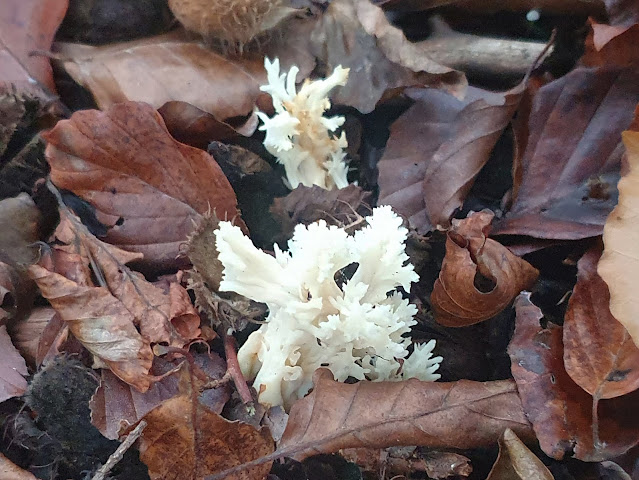Crested Coral, Clavulina cristata or coralloides, Note the slight browning due to ageing. The fused branches rise up from a base typically 1.5 to 2.5cm tall and reach a total height of up to 7cm. The tips of this white to cream coral fungus turn brown with age.
When attacked by micro fungi, this coral can turn grey or even black, making identification more confusing.
Clouded Funnel/Agaric, Clitocybe nebularis, possibly saprobic upon the leaf litter. It is said to form rings or masses. The cap of the mushroom is 5–25 cm (2–8 in) in diameter, convex with an incurved margin, becoming plane to depressed in shape. Cap colours are generally greyish to light brownish-grey, and often covered in a whitish bloom when young.
The surface of the cap is usually dry to moist, and radially fibrillose. The gills are pale, adnate to short-decurrent, close and usually forked. The stem measures 5–10 cm (2–3+7⁄8 in) long and 2–4 cm wide; it is stout, swollen towards the base, becomes hollow with age, and is easily broken. It is usually somewhat lighter than the cap. The flesh is white, and very thick. It usually has a foul-smelling odour, which has been described as slightly farinaceous to rancid.
The Blusher, Amanita rubescens. Probably partly poisonous to some people. Thought to be mycorrhizal.

The Sulphur Tuft, Hypholoma fasciculare, From April through to the first heavy frosts, a walk in mixed woodland rarely fails to reveal Sulphur Tufts fruiting on fallen trees, decaying stumps or, occasionally, hollow trunks of living trees. This wood-rotting fungus is not a fussy feeder it tackles deciduous hardwoods as well as conifers apparently with equal relish, although it is most effective in rotting broadleaf trees (hardwoods), which generally have a higher cellulose content and rather lower lignin content than conifers.Sulphur Tuft is saprobic, feeding on stumps, felled trunks and other dead wood from broad-leaf trees and less commonly conifers. If you see tufts apparently growing in grass it is a certainty that buried roots or other timber and lying just beneath the soil surface. As the root systems of many broadleaf trees extend well beyond the leaf canopy, so also the Sulphur Tuft fungus can fruit quite a long way from the trunk of the decaying tree on which its mycellium is feeding.


The common Puffball, Lycoperdon perlatum. I originally thought this was the Stump Puffball, but was kindly corrected by Andy Overall. Common puffballs are saprotrophic and occur in all kinds of woodland, where they grow on the ground in leaf litter; also, less commonly, in permanent pasture and on sheep-cropped stable sand dunes. More often found in small groups rather than as singletons, the common puffball can occasionally branch like a desert cactus, but most are simple pear-shaped fruitbodies like those shown here.
.









